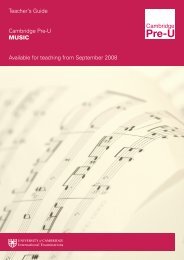Cambridge Pre-U Syllabus - Cambridge International Examinations
Cambridge Pre-U Syllabus - Cambridge International Examinations
Cambridge Pre-U Syllabus - Cambridge International Examinations
Create successful ePaper yourself
Turn your PDF publications into a flip-book with our unique Google optimized e-Paper software.
64<br />
Notes on the use of statistics in Biology<br />
<strong>Cambridge</strong> <strong>Pre</strong>-U Draft<br />
Candidates should know the distinction between descriptive statistics and statistical tests. They should also<br />
appreciate the requirement to choose appropriate statistical methods before planning an investigation in<br />
which they will either collect primary data or analyse secondary data. Candidates should have an<br />
understanding of the different types of variable and also the different types of data that they may collect or be<br />
asked to analyse. These are:<br />
Type of variable Type of data<br />
Qualitative<br />
Categoric Nominal<br />
Ordered Ordinal (ranked)<br />
Quantitative<br />
Continuous Interval (having any value, e.g. 1.0, 2.5, etc.)<br />
Discrete Interval (integers only, e.g. 1, 2, 3, etc.)<br />
For quantitative data, candidates should understand the difference between a normal distribution and a<br />
distribution that is non-normal. Candidates should know appropriate descriptive statistical methods to<br />
simplify their data. They should be able to use a calculator and/or spreadsheet program to find the mean,<br />
median, mode, total range, interquartile range, standard deviation, standard error and 95%CI. Standard error<br />
and 95%CI are useful for expressing the reliability of an estimate of the mean and for putting error bars on<br />
graphs. Candidates should understand how to apply these methods and explain their significance for their<br />
own data and any given data.<br />
Candidates should know when it is appropriate to use a statistical test. They should be able to use statistical<br />
tests to test for an association and when to test for the significance of differences between samples. The chisquared<br />
(χ 2 ) test is used to test the difference between observed and expected frequencies of nominal data.<br />
The chi-squared test allows the evaluation of the results of breeding experiments and ecological sampling.<br />
The t-test is of value in much of Biology to test for the significance of differences between samples.<br />
Candidates should be able to use Pearson’s linear correlation to test for a correlation between two sets of<br />
normally-distributed data and Spearman’s rank correlation to test for a correlation between two sets of data<br />
that are not distributed normally. They should know that a correlation does not necessarily imply a causative<br />
relationship. These statistical methods are dealt with fully in many books and web sites on statistics for<br />
Biology.<br />
Candidates are not expected to remember the following equations and symbols. They are expected to be<br />
able to use the equations to calculate standard deviations and standard errors (which they may use for error<br />
bars on graphs), to test for significant differences between the means of two small unpaired samples and to<br />
perform a chi-squared test on suitable data from genetics or ecology. Candidates will be given access to the<br />
equations, the meanings of the symbols, a t-table and a chi-squared table. In both the t-test and the chisquared<br />
test they should be able to calculate the number of degrees of freedom without any reminders. They<br />
should appreciate levels of significance and use calculated (or given) values of t and χ 2 to make appropriate<br />
conclusions.

















